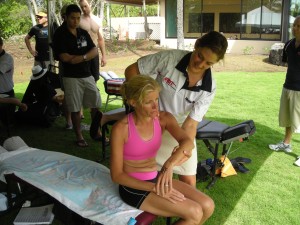I took a walk around the world to ease my troubled mind. I left my body lying somewhere in the sands of time.”
Kryptonite, 3 Doors Down
Your thoughts when injured?
We frequently think of overuse injuries as running related but swimming can also take it’s toll. Swim training/racing can put us at risk for a multitude of upper extremity difficulties. We frequently see problems with the rotator cuff stealing the headlines, particularly in overhead throwing sports, while less commonly the elbow is involved. Many of us have either heard about or experienced Tennis Elbow (pain over the outside of the elbow or Lateral Epicondylitis, less often from playing tennis than from an alternate source despite its moniker.) Triathletes are more prone to Medial Epicondylitis – pain over the inside of the elbow. This is known in the literature as Golfer’s Elbow. You might be able to guess why.
Place your hand on the “bump” over the inside of the elbow, the medial epicondyle. It serves to anchor a host of muscular elements which flex the wrist and fingers. Also, just behind this bony prominence lies the ulnar nerve, a vital structure which provides the nerve supply for much of the strength and sensory in the hand.
Medial Epicondylitis occurs in an overload situation from many etiologies including raking, shoveling, house or garden work, any activity that repeatedly flexes the wrist. Sometimes with greater frequency or force than it’s used to. In triathlon, the causes can be much more subtle and one needs to be aware of this to resolve the pain. Prolonged time in the aero position without a relaxed forearm will result in medial epicondylitis.
Consider the complexity of the swim stroke as it aims to generate power against the water’s considerable resistance. Hand entry and exit into and out of the water are simply the end result of a long musculoskeletal chain, each element of which can have a major role in its resultant accuracy. Alter just one of these links in the chain, head position and corresponding body depth, body roll and its effect on finger entry into the water, etc. and it’s pretty easy to see why elbow problems can be secondary to subtle changes in ones stroke. It’s also important to note that both neophyte and veteran swimmers are susceptible. For example, consider the experienced swimmer who has a little shoulder stiffness after helping a child move from home to college. If the shoulder range of motion is decreased slightly, a subconscious alteration of some other part of the stroke may develop to compensate and voila, medial elbow pain at the conclusion of the work out which only gets worse during subsequent swims.
Thus, like many other overuse entities the cure involves resting the offending elbow, perhaps ramping up kicking and drills until it dissipates, carefully thinking about other aspects of life that put a strain on the joint with the goal of temporary elimination. There may be a role for non-steroidal anti inflammatory type drugs on a short term basis and I really push icing. If one is careful of the skin, 3 or 4 time per day icing can really calm these down and be done almost anywhere. A strengthening program one the pain has decreased can help most everyone can be found at many of the medical/injury websites.
But, unlike many injury situations, the athlete more than the medical community, will have to carefully consider the training changes, or outside training, that may have taken place to both stop the current complaints and prevent their recurrence. Once accomplished, it’s back to swimming and biking as usual, and typical goal oriented triathlete behavior. Happy training!
Cheating in Triathlon
www.johnpostmd.com


